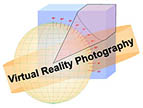

![]() Ask the VR Photography Experts
Ask the VR Photography Experts
![]()
Q: Why is it that so many of the VR panoramas offered on web sites for the latest Hollywood movies are so boring? The latest Harry Potter web site is an example. While it’s interesting to see the empty movie sets, how come it always looks like the place has been abandoned or that a "neutron bomb" went off killing all the people but leaving the structures intact?
![]()
A: In the motion picture and television production world, the unit photographer (stills photographer) is on one of the lowest rungs of the production ladder. Their job is to make photographs that capture the essence of a film or show, but not to interfere with the production of the film in any way as they do it. If they are lucky, they get 10-15 seconds after a take to jump in and shoot the scene with actors/actresses still in character with the set still fully dressed and lit. They can also shoot during rehearsals (but rarely is everything fully set during rehearsals) or even during live takes if they use a camera blimp (a special housing that dampens the sounds of the camera, but restricts operation of the camera much like an underwater housing).
Often, it is the unit photographer's job to shoot VR images of the scenes in addition to traditional stills, although sometimes a "special photographer" will be hired for such specialty photography. As you can imagine, shooting good VR panoramas is almost impossible to do on an active set unless you want to capture all the crew and "off-camera" support equipment. Thus, in order to shoot a set "interior" panorama such as the inside of Hagrid's Hut or Gilderoy Lockhart's classroom from the latest Harry Potter film, the VR photographer has to shoot it on a day when the set is not in use and has been cleared of various production equipment. However, the set still has to have full lighting available (remember that most feature films are shot under union contracts, which restrict everyone from touching or moving any equipment that they aren't authorized to work with -- meaning that a lowly photographer can't simply move a chair or a light stand that happens to be in the way, even if the set is not active).
I have suggested to prominent feature film producers and directors that they could make the VR images that they use for their film's promotion far more compelling by allowing the photographer the time to shoot the panoramas with the film's character's in wardrobe and in place on the set. While they all agree that this would improve the result, none of them can justify the time commitment for the cast and crew that would be required. Thus, feature film VRs continue to remain fairly boring, abandoned-looking location images. Our collective memories of a motion picture usually involve the actions or presence of characters in a scene. Until producers and directors accept the importance of including them and allow the inclusion of related action in their VR promotional material, viewers will have to continue suffering through lifeless VR imagery of empty sets.
![]()
If you're a photographer doing motion picture VR shooting, work with your producers and directors to see if they're willing to let you help them expand the envelope a bit. It might even be as simple as getting time with the actors and actresses on set to shoot images for compositing in your panorama scenes in post production. There's so much potential for compelling VR imagery on major feature film sets. The economy and costs of the production restrict what is practical, but with a little creativity (and support from the heads of production), we have the potential to do far better.
- Scott Highton